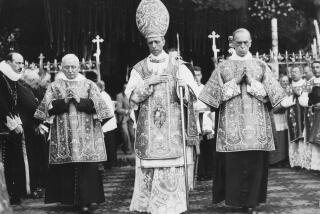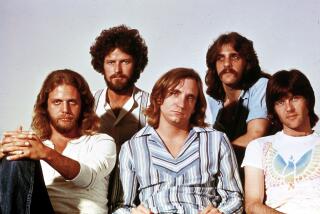Letter Bought by Mormon Church Ruled a Forgery
- Share via
The so-called “White Salamander Letter,” which shook the Mormon establishment by differing with the official account of the church’s origins, is a forgery, according to an expert working for prosecutors in the murder and fraud case against Utah documents dealer Mark Hofmann.
The Salamander Letter is one of 11 allegedly phony documents that Hofmann sold to the church and other collectors, prosecutors said in affidavits unsealed in a Salt Lake City court this week. Hofmann, 31, was arrested Tuesday and charged with killing two people with bombs in an attempt to keep the deception from being discovered.
A documents expert with the Utah attorney general’s office, George Throckmorton, determined that the documents were forged, according to the sworn statements, which were used by investigators to establish “probable cause” to charge Hofmann. The affidavits were unsealed Wednesday after several news agencies successfully argued in court that making them public would not jeopardize a fair trial for Hofmann.
Content of Letter
The Salamander Letter, dated 1830, was purportedly written by Martin Harris, an early convert to the Church of Jesus Christ of Latter-day Saints, as the Mormon Church is formally known. It describes a white salamander that initially prevented church founder Joseph Smith from gaining access to buried golden plates that were later translated into the Book of Mormon. The account, which links Smith to folk magic, is not part of the official church history.
Several of the other documents that Hofmann sold also mention witchcraft practices and vary with official accounts of the early days of the church.
Kenneth Rendell, a historical documents expert in Newton, Mass., told The Times that several prosecutors in the Hofmann case had shown him the questioned papers last week and that he had told them they all were fakes, with one exception: the Salamander Letter.
“But that’s not to say that it wasn’t forged,” he said in a telephone interview Thursday, adding that it would not be difficult for an expert forger to create a document that could escape detection. “In light of the (other) evidence, I’d say overwhelming proof is needed now to show it is genuine ,” Rendell added.
As for the other documents, he said, “All . . . had obvious indications of handwriting forgery.”
One of the bombing victims, Steven Christensen, had hired Rendell in 1984 to authenticate the Salamander Letter. Rendell said that both then and last week he “could not find any indications of normal forgery” in the letter. Christensen, 30, a Mormon bishop, bought the letter from Hofmann for $40,000 and later donated it to the church.
Rendell said it has not been determined where Hofmann got the letter. Hofmann has granted no interviews and has not made a statement to police.
The affidavits say that last year, Christensen asked Curt Bench, a mutual friend, to help find Hofmann because Hofmann was in serious trouble and could face “legal actions” and possible “criminal charges.” Another statement says that a business associate of Christensen overheard a conversation between Christensen and Hofmann on Oct. 10--five days before the bombing that killed Christensen--in which he told Hofmann in a loud voice, “You can’t hide that!”
Church Doesn’t Comment
The Mormon Church had no comment on the case Thursday, but a Mormon historian familiar with the Salamander Letter said, on condition that he not be named, that he still had “no reason to doubt it is authentic.”
Hofmann faces a total of 28 counts, including two of first-degree murder, one of construction or possession of an “infernal machine” and two of delivery of such a device. Thirteen counts accuse Hofmann of theft by deception and 10 charge him with communications fraud.
Seven of the deception counts name the Mormon Church as the victim, and another charges Hofmann with defrauding Gordon B. Hinckley, a member of the church’s First Presidency, the body of highest ruling officers. The church has 5.8 million members worldwide, including about 475,000 in California.
Hofmann, who is being held without bail in the Salt Lake City-County Jail infirmary, is also charged with committing fraud on Christensen and Gary J. Sheets, a Hofmann associate.
Christensen was killed when a pipe bomb exploded in a package he picked up outside his downtown Salt Lake City office last Oct. 15. Sheets’ wife, Kathleen, 50, was killed several hours later outside her suburban Salt Lake home when she lifted a similar booby-trapped package. The parcel was addressed to her husband, who, like Christensen, was trying to get the Salamander Letter authenticated.
Hofmann Hurt by Blast
The next day, Hofmann was critically injured by a third bomb that exploded in his parked sports car in downtown Salt Lake City, a blast that police believe was accidental. He is still recovering, and he appeared in court on crutches.
The documents were sold by Hofmann to the church and Hinckley between October, 1980, and April, 1985, according to the 10 pages of affidavits. Church authorities had never announced the existence of some of the documents.
The affidavits also refer to a so-called McLellin collection of papers said to have been written in the 1830s by a follower of Joseph Smith who had a falling out with the Mormon prophet. Hofmann had recently represented to document dealers and church authorities that he had obtained the writings and would sell them for about $185,000.
But police and church authorities have both said there is no evidence that Hofmann actually possessed such papers--if they exist. However, the affidavits say that Hofmann had shown several potential buyers a piece of papyrus that he claimed was part of the McLellin collection.
Papyrus Fragments
Rendell said in the interview that he had given Hofmann a piece of ancient papyrus on consignment last September. Photos of papyrus fragments shown him by police, who said they found them among Hofmann’s possessions, matched the piece he gave Hofmann, Rendell said Thursday.
“Hofmann was somebody I knew for five or six years,” Rendell said. “I had seen him at antiquarian book fairs. I thought he was a legitimate dealer. . . . I had no reason to question his honesty.”
More to Read
Sign up for Essential California
The most important California stories and recommendations in your inbox every morning.
You may occasionally receive promotional content from the Los Angeles Times.











